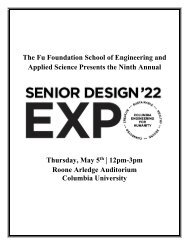Senior Design Expo 2019
The Senior Design Expo, held annually in May at Columbia University, is an opportunity for Columbia Engineering students to showcase what they have learned in their foundational math and science courses together with their engineering courses in innovative, creative, and purposeful designs and prototypes. Each year the Expo showcases more than 60 projects across all nine departments. Projects have included cutting-edge robotics, the New York City subway system, language technology, proposals for bridges to span the Hudson river, and much more.
The Senior Design Expo, held annually in May at Columbia University, is an opportunity for Columbia Engineering students to showcase what they have learned in their foundational math and science courses together with their engineering courses in innovative, creative, and purposeful designs and prototypes. Each year the Expo showcases more than 60 projects across all nine departments. Projects have included cutting-edge robotics, the New York City subway system, language technology, proposals for bridges to span the Hudson river, and much more.
You also want an ePaper? Increase the reach of your titles
YUMPU automatically turns print PDFs into web optimized ePapers that Google loves.
A Non-slip Continuously Variable<br />
Transmission for a Bicycle<br />
Max Holschuh, Nikolay Ionkin, MingxinJia,<br />
Graham Maxwell, and William Zhang<br />
Advisor: Joshua Browne<br />
Bicycles are some of the most popular<br />
vehicles in the world due to their low cost and<br />
convenience. Nearly all bicycles utilize a<br />
single gear ratio or a derailleur design that has<br />
a number of discrete gear ratios. Therefore,<br />
any adjustments to increase the performance<br />
or comfort of a bicycle are significant.<br />
a robust design that fits within a typical<br />
bicycle frame.<br />
ASME codes/standards relevant to<br />
dimensioning, tolerances, and other designrelated<br />
aspects have guided our process. In<br />
addition, ISO 4210 pertains to safety<br />
requirements for bicycles and we have<br />
incorporated this into our design.<br />
Columbia Vector Technologies has<br />
developed a continuously variable<br />
transmission (CVT) that is mounted and has<br />
been tested on a bicycle. The target audience<br />
of the system is an end-user who uses their<br />
bicycle for recreational riding or commuting<br />
in city terrain. The advantages a CVT<br />
provides over a traditional derailleur system<br />
is the lack of intermittent shifting loss and a<br />
simplified shifting process for the operator.<br />
In the past, several CVT designs have been<br />
proposed, but have failed to become<br />
standardized due to various obstacles,<br />
namely the inability to match a gear range<br />
comparable to a derailleur system.<br />
The novel CVT design proposed aims to<br />
solve this issue by eliminating the commonly<br />
accepted use of belts in CVTs, which slip at<br />
high torques, and instead utilizes a ratcheting<br />
mechanism. The gear ratio is varied by<br />
changing the moment applied to a lever arm<br />
that drives an output crank. This lever arm<br />
only engages with the output crank in the<br />
forward direction as it moves back and forth.<br />
In addition, the non-constant RPM output can<br />
be used to the advantage of pedaling. All<br />
CVT components and the bicycle are either<br />
purchased or fabricated within a budget of<br />
$1000 and an extensive engineering analysis<br />
and manufacturing plan is provided to ensure<br />
64








